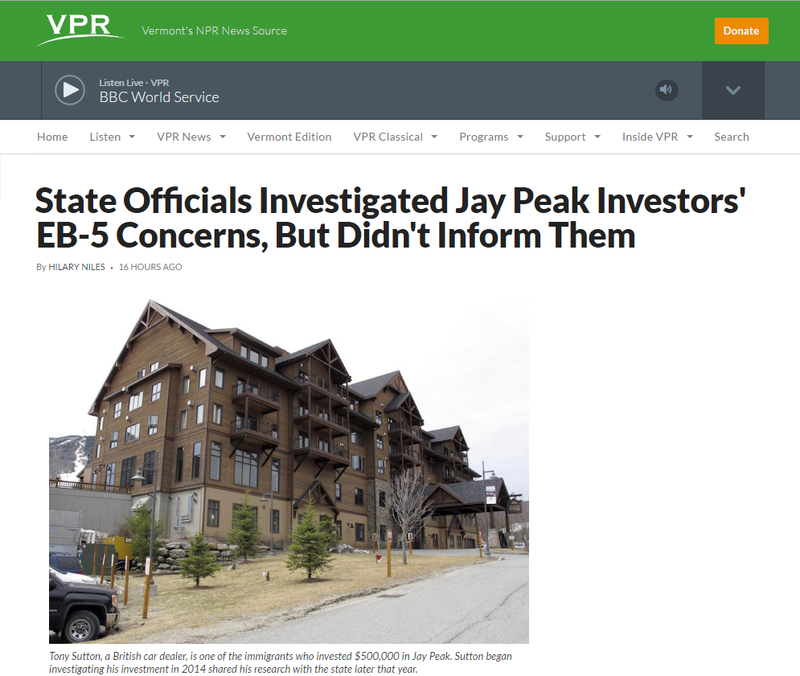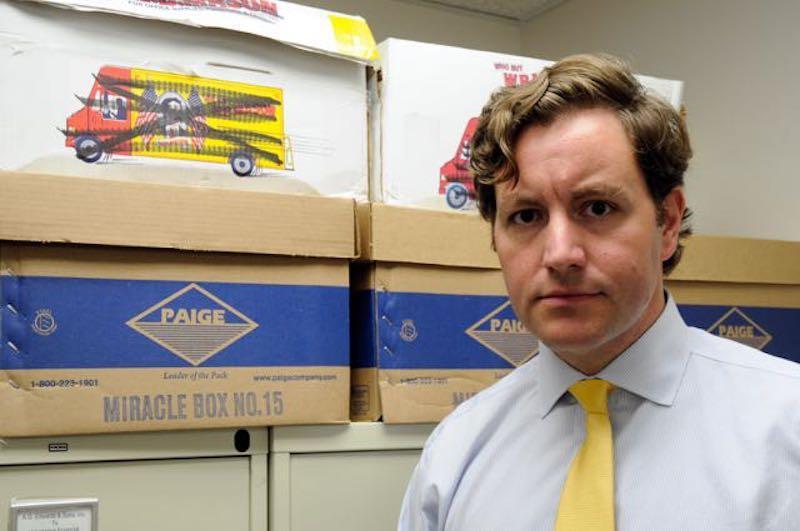State Officials Investigated Jay Peak Investors' EB-5 Concerns, But Didn't Inform Them
Tony Sutton, the British car dealer who pieced together suspicions about Jay Peak’s immigrant-funded EB-5 developments, says he was disappointed with the state's response to the information he provided to regulators months before they took action.
Sutton is one of 35 immigrants who put $500,000 into Jay Peak in 2009. The investment eventually earned them U.S. residency through the federal EB-5 visa program, and it originally made them partial owners of the resort’s Tram Haus Lodge.
It even came with two weeks free vacation — but Sutton says his work at a car dealership in Florida kept him and his family too busy to ever take that perk.
Then in 2014, everything changed. Sutton still hasn’t visited Vermont — but suddenly it was Jay Peak that commanded his time.
“There would be nights where I’d leave work at 8:00 at night and I’d still be working until 1:00 or 2:00 in the morning on Jay Peak,” Sutton says.
January 2014 is when Sutton and the other Tram Haus investors learned that Jay Peak owner Ariel Quiros and resort president, Bill Stenger, had converted their equity to debt the year before. Instead of partial ownership in a hotel, the investors were left holding an unsecured IOU — a promise to pay back their five-year-old investments, but not for another 10 years.
“In real terms, our $500,000 15 years later would have probably been worth a third,” Sutton surmises.
He ended up being the ringleader for a group of about 20 investors who banded together in the wake of this news. They went to Vermont state officials for help, and were told to deal directly with Jay Peak. Quiros and Stenger couldn’t be reached for comment for this story, but Sutton says Stenger stonewalled them.
Still, the more obstacles he encountered, the more determined Sutton became.
And in late 2014, he finally pieced together Jay Peak’s own bank statements, which appeared to show unauthorized transactions.
Vermont’s Commissioner of Financial Regulation, Michael Pieciak, has said Sutton’s work helped launch the state’s official investigation in 2015. But, Sutton says the effort took a toll.
“In honesty, I think that the Jay Peak scenario made it impossible for me to really carry on giving the right amount of attention to my job because the Jay Peak thing literally took over my life,” he says.
"In honesty, I think that the Jay Peak scenario made it impossible for me to really carry on giving the right amount of attention to my job because the Jay Peak thing literally took over my life." — Tony Sutton, Jay Peak investor
Sutton is still working, but now he's back in London. He and the other investors still haven’t gotten back most of their money, and now that Jay Peak is under federal receivership, it’s unclear if they ever will.
But what bothers Sutton most is feeling that state officials left investors to their own devices.
“It’s just been a battle and we never expected to have to fight the state and fight Jay Peak,” he says. “We expected the state to at least investigate or at least take our concerns seriously and they never did.”
Sutton sent his detailed concerns to the state, to let them know what he’d discovered.
Then, as far as he could tell, what happened was: Nothing.
Sutton says he received no response — not an email, not a phone call — from either the state’s EB-5 director, Brent Raymond, or from Commerce Secretary Pat Moulton, who oversees the EB-5 office.
Moulton declined multiple requests for an interview. She said by email that she thought Brent Raymond had written back to Sutton. Raymond didn’t respond to a request for an interview.
But public records show that after receiving Sutton’s email on a Friday, he began grilling Jay Peak officials the following Monday. But Sutton, had no way of knowing.
“If they started asking Stenger questions at that point, they never responded to me,” he says.
"[Sutton's] letter did lead us to ask questions ... In part the [answers] that we got from the project about those questions raised a number of red flags to us and prompted us ... to launch the investigation." — Michael Pieciak, Vermont's Commissioner of Financial Regulation
Moulton also said by email that, to the best of her knowledge, state financial regulators were “verbally told” about Sutton’s documents in late 2014. That’s not what Michael Pieciak recalls. He headed up the state’s securities enforcement at the time.
Commissioner of Financial Regulation Michael Pieciak stands before boxes of evidence Vermont securities officials collected in the course of their investigation into alleged fraud at Jay Peak Resort.
“I do remember receiving and reviewing the letter in January but I don't remember hearing about the letter prior to that,” Pieciak says.
Pieciak says, far from doing nothing, his office launched an investigation of Jay Peak within days of receiving Sutton’s written concerns in January 2015.
“His letter did lead us to ask questions … In part the [answers] that we got from the project about those questions raised a number of red flags to us and prompted us … to launch the investigation,” he says.
However, Pieciak believes his office would have started the investigation even without Sutton’s documents.
By way of example, he says, state officials had already learned that Jay Peak owner Ariel Quiros was under investigation by the US Securities and Exchange Commission. Financial regulators asked about this at their first meeting with Jay Peak officials, on January 28, 2015. The state was told the SEC hadn’t been in touch with Jay Peak for months.
“The next day we called the SEC and … they said they'd been in pretty much constant communication with them [Jay Peak]. The fact that that was an untrue statement made us question the veracity of many of the things they said to us,” Pieciak says. “Mr. Sutton's piece of the puzzle certainly helped but it was certainly just a piece of that puzzle.”
Still, Tony Sutton believes his information pointed the way.
Tony Sutton was among the 35 immigrants who invested $500,000 in Jay Peak in 2009. Sutton's research into his investment is credited, in part, for launching the state's investigation.
“At the end of the day, we showed them what they should be looking at in November 2014. Can they with any justification look back or try and defend doing nothing? Which is what they did.”
In fact, a full-fledged investigation did follow, Pieciak says. It’s just that, nobody told Sutton about it.
“It's not typical to have ongoing communication with a complainant, and particularly in this case, one that has a propensity to speak to the media. Our investigations have to be confidential and private.”
The Department of Financial Regulation also looked into later allegations of fraud at Jay Peak — which just kept coming, Pieciak says. Stenger settled with the SEC last week, but other state and federal charges against him and Quiros are still pending.
Meanwhile Sutton and the other investors are contemplating legal action of their own.
Mentions
- Vermont EB5 Regional Center
- Jay Peak Resort - Tram Haus Lodge
- UNITED STATES SECURITIES AND EXCHANGE COMMISSION
- Ariel Quiros
- Bill Stenger
- Brent Raymond
Litigation Cases
- State of Vermont vs Bill Stenger & Ariel Quiros
- UNITED STATES SECURITIES AND EXCHANGE COMMISSION vs Ariel Quiros & Bill Stenger
States
- Vermont
Videos





Subscribe for News
Site Digest
Join Professionals on EB5Projects.com →
Securities Disclaimer
This website is for informational purposes only and does not constitute an offer or solicitation to sell shares or securities. Any such offer or solicitation will be made only by means of an investment's confidential Offering Memorandum and in accordance with the terms of all applicable securities and other laws. This website does not constitute or form part of, and should not be construed as, any offer for sale or subscription of, or any invitation to offer to buy or subscribe for, any securities, nor should it or any part of it form the basis of, or be relied on in any connection with, any contract or commitment whatsoever. EB5Projects.com LLC and its affiliates expressly disclaim any and all responsibility for any direct or consequential loss or damage of any kind whatsoever arising directly or indirectly from: (i) reliance on any information contained in the website, (ii) any error, omission or inaccuracy in any such information or (iii) any action resulting therefrom.





